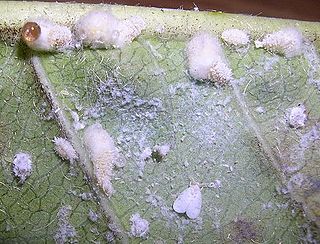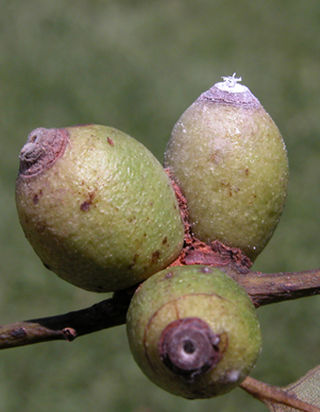Related Research Articles

Mealybugs are insects in the family Pseudococcidae, unarmored scale insects found in moist, warm habitats. Many species are considered pests as they feed on plant juices of greenhouse plants, house plants and subtropical trees and also act as a vector for several plant diseases. Some ants live in symbiotic relationships with them, protecting them from predators and feeding off the honeydew which they excrete.

Scale insects are small insects of the order Hemiptera, suborder Sternorrhyncha. Of dramatically variable appearance and extreme sexual dimorphism, they comprise the infraorder Coccomorpha which is considered a more convenient grouping than the superfamily Coccoidea due to taxonomic uncertainties. Adult females typically have soft bodies and no limbs, and are concealed underneath domed scales, extruding quantities of wax for protection. Some species are hermaphroditic, with a combined ovotestis instead of separate ovaries and testes. Males, in the species where they occur, have legs and sometimes wings, and resemble small flies. Scale insects are herbivores, piercing plant tissues with their mouthparts and remaining in one place, feeding on sap. The excess fluid they imbibe is secreted as honeydew on which sooty mold tends to grow. The insects often have a mutualistic relationship with ants, which feed on the honeydew and protect them from predators. There are about 8,000 described species.

The Sternorrhyncha suborder of the Hemiptera contains the aphids, whiteflies, and scale insects, groups which were traditionally included in the now-obsolete order "Homoptera". "Sternorrhyncha" refers to the rearward position of the mouthparts relative to the head.
Phyllococcus oahuensis was a species of mealybug in the family Pseudococcidae, and the only species in the genus Phyllococcus. It was endemic to Hawaii.
Paratachardina pseudolobata, the lobate lac scale, is a polyphagous and pestiferous lac scale insect, which damages trees and woody shrubs in Cuba, Florida, the Bahamas and the Australian territory of Christmas Island. It was mistakenly identified as Paratachardina lobata (Chamberlin), an insect native to India and Sri Lanka, but was in 2007 recognized and named as a distinct species based on material from Florida; its native distribution is as yet unknown. The new lac insect was described based on all stages of the female, during the revision of the genus Paratachardina, wherein all its known species were redescribed.

Diaspididae is the largest family of scale insects with over 2650 described species in around 400 genera. As with all scale insects, the female produces a waxy protective scale beneath which it feeds on its host plant. Diaspidid scales are far more substantial than those of most other families, incorporating the exuviae from the first two nymphal instars and sometimes faecal matter and fragments of the host plant. These can be complex and extremely waterproof structures rather resembling a suit of armor. For this reason these insects are commonly referred to as armored scale insects. As it is so robust and firmly attached to the host plant, the scale often persists long after the insect has died.
Conchaspis capensis is a species of scale insect from South Africa found on Metalasia muricata and Phylica species. It was originally described by Carl Linnaeus in his 1763 work Centuria Insectorum.

Coccus is a genus of scale insects in the family Coccidae. Several species, such as Coccus viridis, a major pest of coffee, are major agricultural pests. The type species is Coccus hesperidumLinnaeus.
Putoidae is a family of scale insects commonly known as giant mealybugs or putoids. There is probably a single genus, Puto, containing about sixty species. The genus name Macrocerococcus has also been used but it is now considered to be a synonym of Puto. The genus Puto was formerly classified as a member of the Pseudococcidae; however, it so significantly differed from the rest of the Pseudococcidae that it was accorded its own family Putoidae.

Paracoccus marginatus, commonly known as the papaya mealybug, is a small sap-sucking insect in the mealybug family, Pseudococcidae. It is found on a number of different hosts, including economically important tropical fruit trees and various ornamental plants.

Apiomorpha is a genus of scale insect that induces galls on species of Eucalyptus. Galls are initiated by first-instar nymphs (crawlers) on new plant growth and, when mature, the galls exhibit marked sexual dimorphism. Those induced by females are among the largest and most spectacular of arthropod-induced galls whereas those of males are small and most are tubular. Apiomorpha is known only from Australia and New Guinea although its host, Eucalyptus, has a wider distribution into Indonesia as well.

Callococcus is a genus of Australian scale insect that feeds on species of Leptospermum, Hypocalymma, Kunzea and some other members of the tribes Chamelaucieae and Leptospermeae in the myrtle family Myrtaceae. Callococcus leptospermi induces stem-swelling galls on some species of Leptospermum, and it is considered to be a potential biological control agent of Leptospermum laevigatum in South Africa. The other described species of Callococcus do not induce galls.

Dactylopius is a genus of insect in the superfamily Coccoidea, the scale insects. It is the only genus in the family Dactylopiidae. These insects are known commonly as cochineals, a name that also specifically refers to the best-known species, the cochineal. The cochineal is an insect of economic and historical importance as a main source of the red dye carmine. It has reportedly been used for this purpose in the Americas since the 10th century. Genus Dactylopius is also important because several species have been used as agents of biological pest control, and because several are known as invasive species.
John Stuart Noyes is a Welsh entomologist.
Trabutina is a genus of "blue-green" mealybugs, containing five species: T. crassispinosa, T. elastica, T. mannipara, T. serpentina, and T. tenax. This genus of scale insects feeds solely on plants of the genus Tamarix. Its type species is T. mannipara.
"Blue-green" mealybugs are a group of related mealybug genera whose insides, during adulthood, are usually of the color which gives them their collective name. Alternately, this group may be referred to as blue-black mealybugs. It includes the genera Amonostherium, Australicoccus, Melanococus, and Nipaecoccus.

Planococcus ficus, commonly known as the vine mealybug, is a species of mealybug, belonging to the family Pseudococcidae, native to tropical and subtropical regions. The vine mealybug is found in Europe, Northern Africa, Southern Africa, the Americas, and the Middle East. The vine mealybug is invasive to weedy plants in many different regions of the world.
Ferrisia is a genus of mealybugs.

Mary Foley Benson was an American scientific illustrator and fine artist. She specialized in detailed, realistic watercolor paintings of plants and insects.
References
- ↑ CABI Invasive Species Compendium.
- ↑ Yair Ben-Dov (1988). "Manna scale, Trabutina mannipara (Hemprich & Ehrenberg) (Homoptera: Coccoidea: Pseudococcidae)". Systematic Entomology. Volume 13, Issue 4.
- ↑ D.J. Williams and P. J. Gullan (2010). "Family-group names proposed in the family Pseudococcidae (Hemiptera: Sternorrhyncha: Coccoidea)".Zootaxa.
- ↑ Evelyna M. Danzig and Douglass R. Miller (1996). "A Systematic Revision of the Mealybug Genus Trabutina (Homoptera: Coccoidea: Pseudococcidae)." Israel Journal of Entomology, XXX. p. 7.
- 1 2 3 R.A. Donkin (1 December 2013). Manna: An Historical Geography. Springer. pp. 78–79. ISBN 978-94-017-6117-8.
- ↑ Joseph Seckbach; Zvy Dubinsky (11 October 2010). All Flesh Is Grass: Plant-Animal Interrelationships. Springer Science & Business Media. p. 111. ISBN 978-90-481-9316-5.
- ↑ Jolivet (1 January 1992). Insects and Plants: Parallel Evolution & Adaptations, Second Edition. CRC Press. p. 119. ISBN 978-1-877743-10-8.
- ↑ Masumeh Moghaddam (23 September 2013). An Annotated Checklist of the Scale Insects of Iran (Hemiptera, Sternorrhyncha, Coccoidea) with New Records and Distribution Data. PenSoft Publishers LTD. p. 74. ISBN 978-954-642-702-1.
- ↑ Yair Ben-Dov (1988). "Manna scale, Trabutina mannipara (Hemprich & Ehrenberg) (Homoptera: Coccoidea: Pseudococcidae)". Systematic Entomology. Volume 13, Issue 4. p. 388, 389.
- ↑ M. Bertholet (1862). "On the Manna of Sinai, and the Manna of Syria". The Pharmaceutical Journal and Transactions. Second Series, Volume 3. p. 274.
- ↑ S. Mark Henry (17 September 2013). Symbiosis: Associations of Invertebrates, Birds, Ruminants, and Other Biota. Elsevier. p. 120. ISBN 978-1-4832-7592-5.
- ↑ M. Mani; C. Shivaraju (24 February 2016). Mealybugs and their Management in Agricultural and Horticultural crops. Springer India. p. 138. ISBN 978-81-322-2677-2.
- 1 2 Vincent B. Wigglesworth (6 December 2012). The Principles of Insect Physiology. Springer Science & Business Media. p. 497. ISBN 978-94-009-5973-6.
- ↑ Moshe Coll; Eric Wajnberg (25 July 2017). Environmental Pest Management: Challenges for Agronomists, Ecologists, Economists and Policymakers. Wiley. p. 116. ISBN 978-1-119-25556-7.